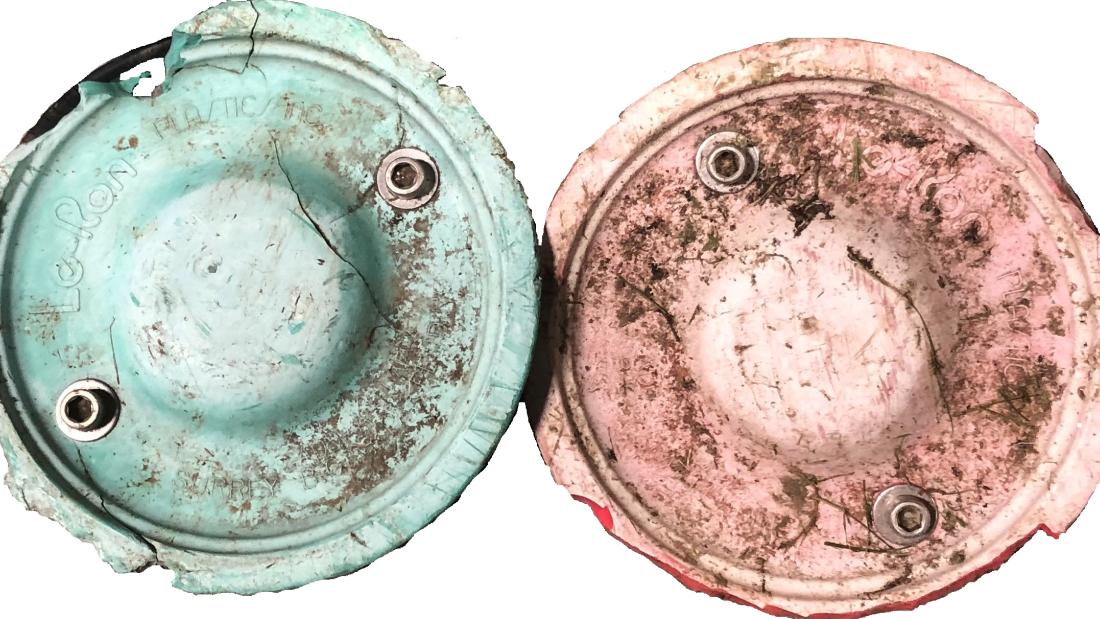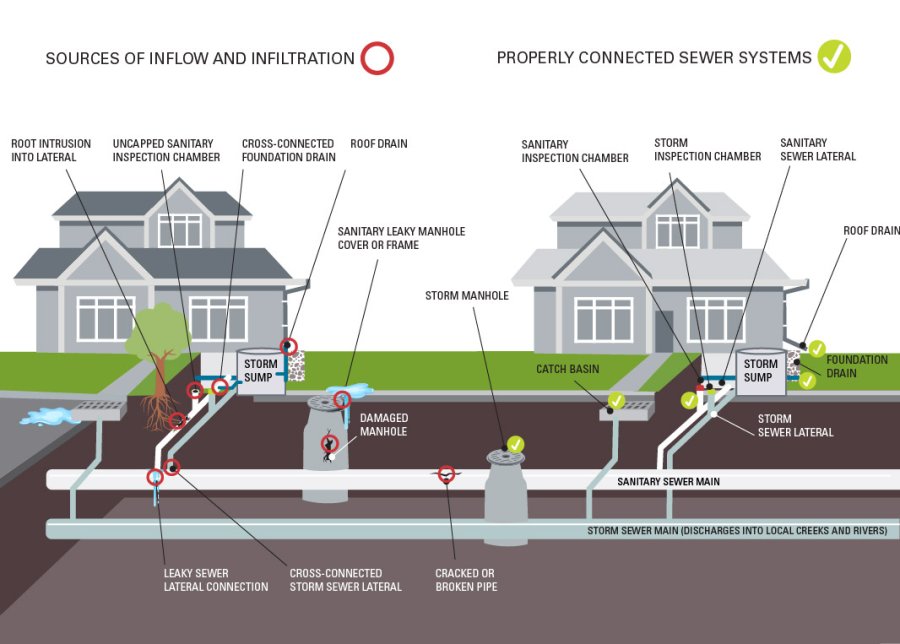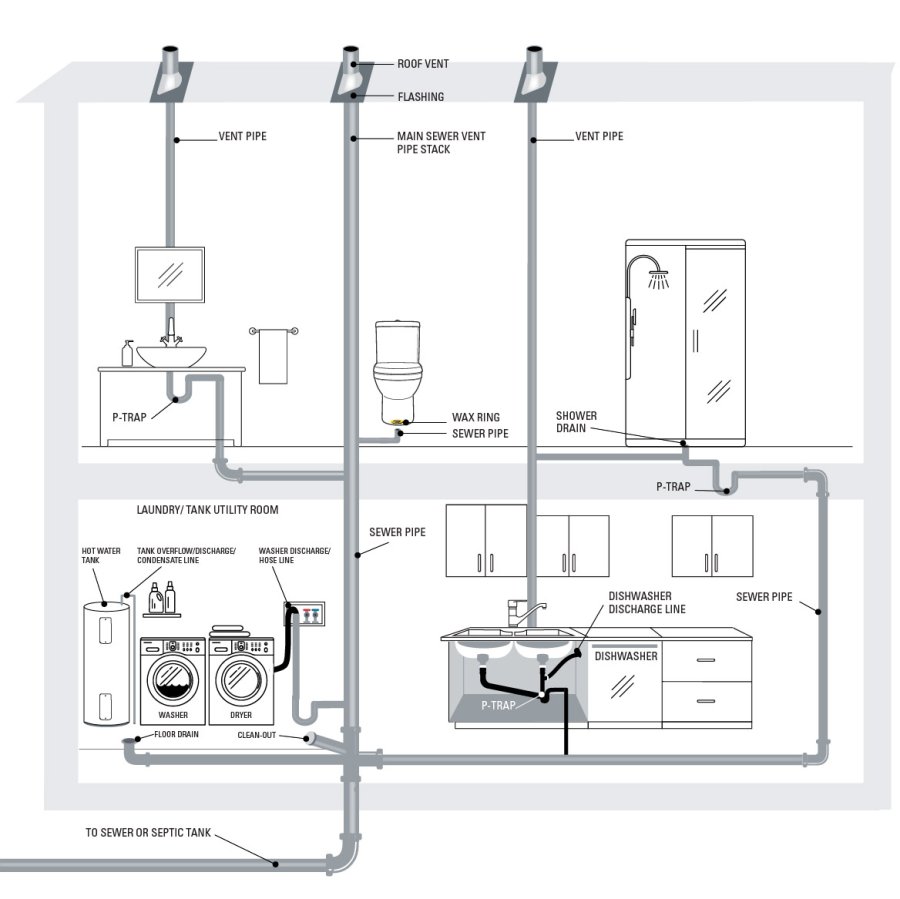Sanitary Sewer Issues
Learn to identify sanitary sewer issues and how to resolve them.
Resolving Sanitary Sewer Issues
If you are experiencing an issue with the sanitary sewer service at your home or business, how you report it depends on which type of system you have:
Vacuum Systems
Call the City at 604-591-4152 if:
- The vacuum chamber is full or overflowing
- You hear a hissing or vacuum noise
- All your toilet sinks, showers, or tub drains are not working
Do not call the City if only a single toilet or sink within the home is experiencing problems (and other fixtures are fine). It is most likely a private issue and is the property owner’s responsibility.
Gravity Systems
Call the City at 604-591-4152 immediately if:
- Sewer manholes on the street or boulevard are overflowing, missing, or damaged
Call the City at 604-591-4152 or Report a Problem online if:
- Your inspection chamber is full or overflowing
- All your toilet sinks, showers, or tub drains are not working
- You have a missing or damaged inspection chamber lid or other inquiry
City staff will investigate. If we can access the inspection chamber and there is a blockage on the City side, we will clear it at no cost to the property owner. If there is a missing or damaged lid, we will replace it at no cost. If the issue is deemed to be on the private side, the property owner will bear all costs.
If we cannot locate the inspection chamber, or if it is inaccessible, the property owner must ensure it is accessible before crews can continue. In some cases, property owners can use an approved City of Surrey contractor to assist. Call us for more information.
Do not call the City if only a single toilet or sink within the home is experiencing problems (and other fixtures are fine). It is most likely a private issue and is the property owner’s responsibility.
Low Pressure Systems
Call the City at 604-591-4152 if:
- Neighbouring or multiple nearby properties also on LPS are also experiencing sewer systems
For other issues, LPS systems 2005 and newer are deemed private all the way to the city mainline and are the property owner’s responsibility. Call a certified plumber familiar with LPS systems.
Some LPS systems prior to 2005 have shared responsibilities between the City and property owner at property line.
Septic Systems
Septic Systems are private and are the property owner’s responsibility.
To report a failing septic system issue, contact Fraser Health Authority at 604-587-3936
Not sure what type of system you have? Learn about the different types of sewer systems in Surrey. Read on for explanations of various issues you might encounter with your sewer system.
Sanitary Sewer Backups
If you are experiencing a sewer backup, call 604-591-4152. In case of injury or immediate danger, call 911.
Sewer backups within a home can occur for many reasons:
- Non-flushable items clog the pipes and obstruct flow
- Tree roots enter the system and restrict flow
- Excessive grease deposits from cooking within the pipe system restrict flow
- Broken or collapsed pipes
- Misaligned joints
- Damaged or missing sewer covers
- Large atmospheric rain events which can overburden the system, not allowing storm sewer services from homes to discharge into larger city mains
- Internal plumbing issues
- Broken water service which can cause localized flooding
Determining Where the Problem Is
Our first priority is to determine whether the issue is on private property or on the City side. Some systems such as septic or low-pressure sewer systems are the homeowner’s responsibility.
Usually, for gravity systems that have inspection chambers, the point of blockage determines who pays the cost of clearing the pipe. The portion of the pipe on City property is the responsibility of the City of Surrey, and the portion of the pipe on private property or sometimes between Right of Ways or third-party agreements amongst properties is the responsibility of the owner.
If the inspection chamber is inaccessible or does not exist in older properties, then the proof as to whether the issue resides on City property lies with the property owner. A private plumber or contractor would need to prove with a closed-circuit camera television plumbing inspection tool to an onsite City representative in order for the City to accept responsibility, deal with the blockage and re-instate service.
Clearing of blockages or pipes on the City side without City staff onsite would not be reimbursed. If the blockage of a sewer service is also determined to be due to the property owner’s own negligence (e.g. broken lids from vehicles driving on top of inspection chambers which do not have appropriate protective covers) then the City can also recover any costs associated with attending to the property.
Submitting a Claim for a Sewer Backup
If you have sustained any injury, loss or damage to yourself, home or property, contact your insurance carrier. The City cannot do any work on private property in relation to any potential loss. Therefore, it is your responsibility to mitigate any damages that have occurred or are occurring.
Any damages or costs incurred need to be filed with a Notice of Claim Form through the City of Surrey Risk Management Division. Call 604-591-4529 for more information.
The Local Government Act requires that the City Clerk receive a Notice of Claim within two months of the date of loss. Once the completed form has been received, Risk Management will acknowledge receipt for the notice and investigate the incident. The City will make a decision and inform you whether or not the City will be providing compensation.
Fix the Root Issue Causing the Sewer Backup
Unplugging a blocked sewer drain may solve the immediate problem for a homeowner but it is no guarantee that the issue will not re-occur. It is important to know and understand what or how the blockage was caused.
Shortcuts often lead to bigger issues. For example:
- Tree roots on the private side enter the sewer pipe and cause a blockage
- The homeowner or contractor reinstate the service with an auger or root cutting tool
- The issue may reoccur again since roots will grow back.
- Excessive cleaning with auger or root cutters can also degrade the sewer pipe, causing pipe failure leading to emergency and costly repairs.
Using a contractor with access to a closed-circuit television plumbing inspection camera allows for visual inspection inside the pipe and can help determine how the issue occurred or what future measures need to be taken to prevent it from happening again.
It is up to the property owner to decide whether to apply a long-term solution for any issues that are on the private side and fall under their responsibility.
When City staff attend to investigate an issue on the City side, we video inspect the sewer service to ensure any other immediate issues have been dealt with or if they require follow-up.
Damaged or Missing Inspection Chamber Lids
Report missing or damaged lids immediately through Report a Problem or call 604-591-4152.
The sewer inspection chamber lid is a protective cover with locking tabs that allows City personnel access to the inspection chamber cleanout for sanitary or storm services. Lids are made of PVC with minor variations amongst manufacturers. Homes built prior to the 1980’s may have lids and inspection chambers made of concrete.
Broken, cracked or missing lids can lead to potential sewer backups and damages due to the pipe being blocked or having debris fall in. Missing or unsecure inspection chamber lids can also be potential tripping hazards.

Inspection chamber lids can break from:
- Vehicle loading: vehicles driving on top without appropriate protective covers in place such as meter-brooks boxes or M.R. 10 valve style metal lids.
- Illegal driveway extensions, asphalt paving, brickwork, concrete or other materials.
- Unauthorized access from non-city personnel without resecuring the inspection chamber lid.
- Landscaping, lawnmowing, construction of retaining walls or features without exposing the inspection chamber.
- Tree roots that can exert pressure onto the riser pipe and make it out of round so a lid cannot be secured.
Inflow and Infiltration
Surrey has separate storm and wastewater systems. When rainwater and groundwater is in the wastewater system, it is called inflow and infiltration. This reduces the system's ability to convey wastewater. This may cause sewer backups into homes or businesses, or overflows to roads, creeks, or sensitive habitat areas.
Sometimes stormwater runoff is illegally tied into the wastewater system or wastewater is present in a storm system. These are called cross connections.
Metro Vancouver requires all local municipalities to limit the amount of rainwater and groundwater in the wastewater system under the Integrated Liquid Waste and Resource Management Plan.
Other sources of inflow and infiltration include:
- Root intrusion from trees and shrubs planted too close to sewer pipes. This can penetrate pipes and create cracks, holes and openings allowing for inflow and infiltration.
- Broken or poorly connected sewer pipes.
- Missing, broken, or unsecured inspection chamber and cleanout lids.
- Illegal plumbing connections from home renovations or discharging from recreational vehicles and trailers.
Sewer-like Odours
Not all bad smells are sewer related. Ensure you know the source of the smell before reporting it to the City.
Things to check for prior to calling the City of Surrey:
- Have your internal plumbing inspected by a certified plumber to be in good operating order. This includes P traps, roof vents, wax seals for toilets and no cracks or holes in the plumbing pipes.
- Check to see if the issue is related to only a specific property or a widespread area.
The odour could be from one of these sources that are commonly mistaken as sewer issues:
Farming
Odours are created when farmers plow or fertilize their fields. For example, livestock, poultry, and mushroom farms.
Metro Vancouver Trunk Mains
Large sewer trunk mains owned and operated by Metro Vancouver funnel City sewer to wastewater treatment facilities. When these are flushed, used, or cleaned they sometimes produce an odour. You might smell it if your property is adjacent to this infrastructure.
Metro Vancouver has odour reducing devices to reduce the odour as much as possible, but you may still get some odour from time to time.
Rodents and Small Animals
Small animals like mice and rats can find their way into small areas underneath sheds, homes, and patios. Their fecal matter or decaying bodies can produce a strong odour that permeates throughout a home or area.
Contact the Fraser Health Authority with issues regarding small animals like mice and rats.
P Traps
P traps are necessary to prevent sewer gases from coming up through the plumbing fixtures in your home. The water in the P trap prevents odours from travelling back into your home. If you do not have P traps installed or they are dry and not full of water due to inactive use, you could experience sewer odours in your home.
Run water through all your plumbing fixtures (showers, toilets, sinks, tubs) before leaving on a trip for an extended period. If you don’t, the water within the P traps can evaporate and cause odour issues.
Proper plumbing permits during new or renovation construction are required to make sure P traps are installed and functioning correctly.
Wax Seals for Toilets
Properly installed wax seal toilet rings are necessary to prevent odour. The wax ring must be replaced with a new one every time the toilet is removed. If your toilet is not stable, or rocks back and forth, the wax ring is likely not properly seated and will allow for sewer odours to enter your building.
Blocked Roof Vents
Sometimes plumbing roof vents for bathrooms and plumbing fixtures get clogged with leaves or animal nests. Maintain and keep your vents clear to prevent odours and to ensure wastewater can be properly discharged.
If there is gurgling or poor draining in your plumbing, check that there is no debris in the discharge pipe and that the vent pipe is clear. Poorly fitted pipes and fittings along with cracks and holes in plumbing pipes can allow for sewer odours to leak into the home if not corrected.
Waste Carts & Compost
Your—or your neighbour’s—waste carts and compost bins can give off pungent odours, especially if they have been in extreme heat or have recently been turned over.
- Use secure compost bins which can be turned over or mixed more easily
- Keep compost material moist to keep odours down
- Place newspapers in the organics bin and wash your carts out to minimize odours
Industry (Processing & Rendering Plants)
Surrey has businesses that can produce odour (like fertilizer production, fish processing, and rendering plants). The odour can be increased if their odour control equipment is not working correctly.
Contact Metro Vancouver or Fraser Health Authority if you have a complaint about industrial odour.
Contacts for Air Quality and Sewer-like Odours
Metro Vancouver
Information about odour, dust, and air contaminant complaints
Phone: 604-436-6777
Email for general inquiries: aqinfo@metrovancouver.org
Outside of Metro Vancouver
BC Ministry of Environment
Phone:1-877-952-7277
Indoor workplace air quality concerns
WorkSafeBC
Phone: 604-276-3100
Fraser Health Authority
Contact the Population Health Call Centre at 604-587-3936 and request to be connected to an environmental health officer in the Water and Land Program for health and safety concerns or complaints about:
- Onsite sewerage or septic tank failure
- Sewer overflows on private property
You can also e-mail HPLand@fraserhealth.ca or contact the local Fraser Health Authority Surrey Health Protection Office at 604-930-5405.

